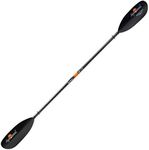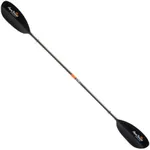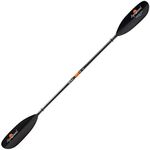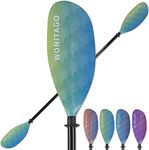Buying Guide for the Best Kayak Paddles
Choosing the right kayak paddle is essential for a comfortable and enjoyable paddling experience. The right paddle can make your strokes more efficient, reduce fatigue, and help you maneuver your kayak with ease. When shopping for a kayak paddle, it's important to consider how and where you'll be paddling, your body size, and your paddling style. Understanding the key specifications will help you find a paddle that fits your needs and enhances your time on the water.LengthPaddle length refers to the distance from one end of the paddle to the other. This is important because the right length helps you paddle efficiently without straining your arms or back. Shorter paddles are generally better for smaller kayaks or for paddlers with a shorter torso, while longer paddles are suited for wider kayaks or taller paddlers. To choose the right length, consider your height and the width of your kayak. If you have a wider kayak or are taller, go for a longer paddle; if you have a narrow kayak or are shorter, a shorter paddle will be easier to handle.
Blade Shape and SizeThe blade is the part of the paddle that goes into the water, and its shape and size affect how much power you get with each stroke. Larger blades provide more power but require more effort, making them suitable for strong paddlers or those who want to move quickly. Smaller blades are easier to use for longer periods and are better for beginners or those who prefer a relaxed pace. The shape can be long and narrow for smoother, easier strokes, or short and wide for quick, powerful strokes. Think about your strength and how you plan to paddle—choose a blade size and shape that matches your comfort and paddling goals.
MaterialPaddle materials affect the weight, durability, and price of the paddle. Common materials include aluminum, fiberglass, and carbon fiber. Aluminum paddles are heavier but durable and affordable, making them good for casual use. Fiberglass paddles are lighter and offer a good balance of performance and cost, suitable for regular paddlers. Carbon fiber paddles are the lightest and most efficient, ideal for those who paddle long distances or want the best performance. If you plan to paddle often or for long trips, a lighter material will reduce fatigue; for occasional use, a heavier but sturdy paddle may be sufficient.
Shaft TypeThe shaft is the long part you hold, and it can be straight or bent. A straight shaft is simple and common, suitable for most paddlers. A bent shaft has a slight angle, which can make paddling more comfortable and reduce strain on your wrists during long trips. Some shafts are also adjustable in length or can be taken apart for easy transport. If you have wrist issues or plan to paddle for hours, a bent shaft might be more comfortable; otherwise, a straight shaft works well for general use.
FeatheringFeathering refers to the angle between the two blades of the paddle. Some paddles have blades that are aligned (unfeathered), while others are offset at an angle (feathered). Feathered paddles can reduce wind resistance, making paddling easier in windy conditions. Many paddles allow you to adjust the feathering angle. If you often paddle in windy areas, a feathered paddle can help; if not, an unfeathered or adjustable paddle gives you flexibility.
WeightThe overall weight of the paddle affects how tired you get while paddling. Lighter paddles are easier to use for long periods and reduce arm fatigue, while heavier paddles can be more tiring but are often more affordable. If you plan to paddle for long distances or have any arm or shoulder issues, a lighter paddle is a better choice. For short trips or occasional use, weight may be less of a concern.
















